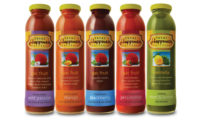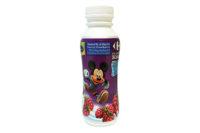Health concerns are a major issue for many people. The United States’ first lady Michelle Obama has headed up the Let’s Move program to educate consumers about “America’s Move to Raise a Healthier Generation of Kids.” Her efforts also have led to trying to get more adults and children involved in healthier food and beverage choices.
Other programs also have tried to reduce sugar consumption, and the beverage market has responded with new formulations that can reduce the sugar content of beverages by using alternative sweeteners that still can provide the sweet flavor that consumers demand but in low- or no-calorie formulations.
To meet this demand, beverage-makers increasingly are using stevia and other natural sweetener alternatives like erythritol in beverage formulations, according to Thom King, president of Steviva Ingredients Inc., Portland, Ore. Additional pressure from consumers and government agencies to provide more clean-label products also has helped to make natural alternative sweeteners a “go-to” option, he says.
In addition, stevia and erythritol are well tolerated by people’s digestive systems because the ingredients come from all-natural sources, King says. They also have the lowest gastrointestinal impact of any alcohol sugar, he explains. Erythritol has the lowest molecular weight of all the polyols with a molecular mass of 122.1198. Therefore, its weight as well as the fact that it is only 70 percent as sweet as sugar makes it ideal for use as a bulking agent in tandem with stevia, King explains. Erythritol is 0.2 calories per gram, and stevia is zero, which can help to deliver the lower-calorie labels consumers are looking for, he adds.
Major beverage manufacturers have utilized these natural sweeteners in conjunction with full-calorie sweeteners in new carbonated soft drink (CSD) formulations. Last summer, The Coca-Cola Co., Atlanta, test-launched Coca-Cola Life in The Fresh Market locations across the Southeast. In late 2014, the company announced that Coca-Cola Life now is available at retailers nationwide. Utilizing cane sugar and stevia leaf extract, Coca-Cola Life contains 60 calories in each 8-ounce serving.
“We ultimately want to be leaders in this emerging segment, and Coca-Cola Life is our first effort to make this a reality,” said Andy McMillin, vice president of Coca-Cola brands for Coca-Cola North America, in a statement. “For consumers looking for a reduced-calorie soft drink sweetened with cane sugar and stevia leaf extract, this is a great-tasting option.”
Purchase, N.Y.-based PepsiCo Inc. also has explored using stevia leaf extract in its CSD offerings. In late 2014, the company announced the development of Pepsi True, which is sweetened with sugar and stevia leaf extract. A 7.5-ounce mini-can contains 60 calories and 16 grams of sugar, the company says.
In addition, the government is considering proposing new labeling guidelines on the food and beverage industry. For example, the U.S. Food and Drug Administration (FDA) proposed that consumer packaged goods companies should be required to include information about any added sugars on the Nutrition Facts label. “Many experts recommend consuming fewer calories from added sugar because they can decrease the intake of nutrient-rich foods while increasing calorie intake,” the FDA says on its website.
As such, there has been an increase in customers requesting clean-label sugar reduction, Steviva’s King says.
Ingredient suppliers are taking notice of the attention that stevia has gained in beverage formulations and are developing more products to meet this need. Last year, Minneapolis-based Cargill introduced its ViaTech line of stevia-based sweeteners. The sweetener line enables beverage-makers to achieve optimal sweet taste at high-use levels, which has been a limitation with previous stevia-based products, the company says. When used in combination with Cargill’s proprietary taste prediction model, ViaTech also can help achieve a clean sweetness even in some difficult zero-calorie and reduced-calorie beverage formulations, it adds. Cargill scientists have extensively researched the stevia leaf to understand how the different steviol glycosides found within it work alone and in combination. This approach allows Cargill developers to focus not only on optimizing taste and sweetness but also on creating ingredients that enable a sensible total formulation cost for food and beverage manufacturers, it says.
Monk fruit also offers beverage-makers a natural alternative. Steviva released its MonkSweet plus, a natural sweetening solution that combines three branded ingredients — SteviaSweet 95-60, monk fruit extract and Erysweet Erythritol — in a proprietary blend. The ingredient is twice as sweet as sugar and has just 0.2 calories per gram, the company says. It can be plugged into formulations at a 1-to-2 ratio for sucrose or high-fructose corn syrup to reduce calories and enhance flavor, it adds. It also features a GMO-free profile, kosher certification, and a low-glycemic load that is safe for diabetics. MonkSweet plus also is highly soluble as well as non-fermenting and is appropriate in a wide range of formulations because it works well with other sweeteners and is heat-, shelf- and pH-stable, the company says.
Tackling taste
Perhaps one of biggest challenges in utilizing these natural sweeteners is hitting the exact sweetness curve as desired, Steviva’s King says. However, flavor experts are finding ways to enhance the performance to meet the consumer demand to use less sugar and still provide the taste profiles they have come to expect.
Occasionally, trying to blend polyols and stevia or monk fruit can leave the mouthfeel a little thin, King notes. By adding low levels of fructooligosaccharides (FOS) or xanthan gum, beverage-makers can improve the mouthfeel and reach a comparable feel to using a sugar syrup but without the calories or other negative impacts, he says. FOS will add bulk, but the non-digestible fructose and glucose molecules, which are derived from the chicory root, act as a prebiotic to support growth of healthy microflora in the gut, he adds.
However, masking agents can be necessary when working with these types of sweeteners in order to achieve a flavor profile that consumers expect. From its formulation experience, Steviva has found that small amounts of added burnt sugar, caramel and vanilla flavors can help to mask off-notes associated with stevia, King says. The presence of citric acid, tartaric acid or lactic acid in the system also will improve the taste of stevia by cutting the lingering sweetness, he notes. Also, certain flavors, such as ginger, cola and root beer will diminish the licorice notes of stevia, while sour notes such as grapefruit can be used to mask the aftertaste associated with intense sweeteners, King adds.
In general, erythritol can be used to mask off-notes left behind by high-intensity sweeteners, and a masking agent will handle what might be left, King says.
Whether using them with stevia or erythritol, some masking agents will not hold up well under heat, particularly agents that are derived through a fermentation process, King notes. Steviva uses a panel of taste testers to retrieve information on sensorial and temporal data and determine which masking agents will work best, he adds.
“It has been our fortune that we have not been required to use masking agents very often as we can rely upon our line of bulking sweeteners to accomplish the task for us,” King says. “That would include erythritol, xylitol, crystalline fructose, and FOS. In the off chance we would need a masking agent, we generally depend on enzymatic maskers or flavors.”
Controlling the supply
As with any ingredient, suppliers want to ensure consistent quality for their stevia and erythritol ingredients. Steviva uses two suppliers in China to manufacture its stevia products and a manufacturer in Markelsheim, France, to make its Erysweet erythritol product, according to King. “We use locally sourced, non-GMO corn byproducts [to make Erysweet],” he says. “The stalks, cobs and husks are turned into a slurry, and the natural glucose is extracted. Yeast is then introduced, and the final liquid is put into a drying bed to crystalize, and the end result is erythritol, King says.
Within its alternative sweetener portfolio, Steviva offers a branded line of Erysweet erythritol; SteviaSweet 95-60 stevia extract; SteviaSweet RA98 Rebaudioside A; Nectevia, a stevia-fortified agave nectar; MonkSweet, a monk fruit sweetener; a stevia-erythritol blend for beverages; XeroSweet – Xylitol; FruSweet, a non-GMO crystalline fructose; SteviaSweet liquid stevia solution; Steviva Blend, an erythritol-stevia blend in both 10x powder and 40 mesh; and dozens of proprietary and custom sweetening systems, King says.
According to the Global Stevia Institute, stevia is approved for use in food and beverages in 65 countries and is pending approval in three more. That includes 17 countries in North and South America.
Chicago-based Euromonitor International states that stevia has gained acceptance as the first natural, healthy sweetener, according to its January 2014 report “Stevia: Adding Value Through Natural – The Resurgence of Reduced Sugar.” The report suggests that stevia could help in weight management by helping to reduce caloric intake. If 20 percent of all regular, full-sugar carbonates were reformulated to include stevia, consumption of reduced-sugar carbonates could increase to 58.6 million liters by 2017 compared with the forecast of 26.9 billion liters, which could result in an annual per capita intake reduction of more than 6,000 kilo-calories, according to the report. Stevia not only reduces calories by reducing sugar content, it also offers naturalness, health benefits, and additional appeal to the mass market, it says.
Also, innovation has led to technological advances with alternative sweeteners. New blends of steviol glycosides have served to improve the taste profile of products and allowed a 50 percent sugar reduction compared with other substitutes that allow only 30 percent, Euromonitor’s report states.






